Itron NIC44 Radio module User Manual Understanding Silver Spring Networks Access Points
Silver Spring Networks Radio module Understanding Silver Spring Networks Access Points
Itron >
User Manual

Understanding Silver Spring Networks Access Points 4 March 2013 Silver Spring Networks 2
Understanding Silver Spring Networks Access Points
Copyright © 2013 Silver Spring Networks, Inc. All rights reserved.
The Silver Spring Networks logo, UtilityIQ®, and UtilOS® are registered trademarks of Silver Spring Networks, Inc.
GridScape™, CustomerIQ™, and Direct-to-Grid™ are trademarks of Silver Spring Networks, Inc.
All other company and product names are used for identification purposes only and may be registered trademarks,
trademarks, or service marks of their respective owners.
Please consider the environment before printing this document.
Customer Support
Country Email Telephone Hours
Australia aus-support@silverspringnet.com 1300 706 769 9:00 AM - 9:00 PM
Australia Eastern Time
Canada support@silverspringnet.com Toll free:
1-888-SSN-9876
(1-888-776-9876)
5:00 AM - 6:00 PM
US Pacific TimeUnited States
Worldwide +1-650-298-4298
Contact us on the Web http://www.silverspringnet.com/services/customer-support.html

Understanding Silver Spring Networks Access Points 4 March 2013 Silver Spring Networks 3
Understanding Silver Spring Networks Access Points Contents
Contents
1. About Access Points. . . . . . . . . . . . . . . . . . . . . . . . . . . . . . . . . . . . . . . . . . . . . . . . . . . . . . . 4
Overview. . . . . . . . . . . . . . . . . . . . . . . . . . . . . . . . . . . . . . . . . . . . . . . . . . . . . . . . . . . . . . . . . . . . . . . . 4
Features . . . . . . . . . . . . . . . . . . . . . . . . . . . . . . . . . . . . . . . . . . . . . . . . . . . . . . . . . . . . . . . . . . . . . . . . 5
AP Product Description . . . . . . . . . . . . . . . . . . . . . . . . . . . . . . . . . . . . . . . . . . . . . . . . . . . . . . . . . . . . 5
Battery Backups . . . . . . . . . . . . . . . . . . . . . . . . . . . . . . . . . . . . . . . . . . . . . . . . . . . . . . . . . . . . . . . . 6
Read Storage . . . . . . . . . . . . . . . . . . . . . . . . . . . . . . . . . . . . . . . . . . . . . . . . . . . . . . . . . . . . . . . . . . 7
Power Requirements . . . . . . . . . . . . . . . . . . . . . . . . . . . . . . . . . . . . . . . . . . . . . . . . . . . . . . . . . . . . 7
Rebooting or Recycling APs . . . . . . . . . . . . . . . . . . . . . . . . . . . . . . . . . . . . . . . . . . . . . . . . . . . . . . . 7
Standards Compliance . . . . . . . . . . . . . . . . . . . . . . . . . . . . . . . . . . . . . . . . . . . . . . . . . . . . . . . . . . . 7
Cellular Modem . . . . . . . . . . . . . . . . . . . . . . . . . . . . . . . . . . . . . . . . . . . . . . . . . . . . . . . . . . . . . . . . . 8
Addressing Schemes . . . . . . . . . . . . . . . . . . . . . . . . . . . . . . . . . . . . . . . . . . . . . . . . . . . . . . . . . . . . 8
Specifications . . . . . . . . . . . . . . . . . . . . . . . . . . . . . . . . . . . . . . . . . . . . . . . . . . . . . . . . . . . . . . . . . . 9
European Union Compliance . . . . . . . . . . . . . . . . . . . . . . . . . . . . . . . . . . . . . . . . . . . . . . . . . . . . . 10
Maintenance Procedures . . . . . . . . . . . . . . . . . . . . . . . . . . . . . . . . . . . . . . . . . . . . . . . . . . . . . . . . 11
Surge Protection . . . . . . . . . . . . . . . . . . . . . . . . . . . . . . . . . . . . . . . . . . . . . . . . . . . . . . . . . . . . . . . 12
Redundant WAN Option . . . . . . . . . . . . . . . . . . . . . . . . . . . . . . . . . . . . . . . . . . . . . . . . . . . . . . . . . 12
Mounting Options . . . . . . . . . . . . . . . . . . . . . . . . . . . . . . . . . . . . . . . . . . . . . . . . . . . . . . . . . . . . . . 12
WAN Options . . . . . . . . . . . . . . . . . . . . . . . . . . . . . . . . . . . . . . . . . . . . . . . . . . . . . . . . . . . . . . . . . 12
Throughput Performance . . . . . . . . . . . . . . . . . . . . . . . . . . . . . . . . . . . . . . . . . . . . . . . . . . . . . . . . 13
Responding to a WAN Failure . . . . . . . . . . . . . . . . . . . . . . . . . . . . . . . . . . . . . . . . . . . . . . . . . . . . 16
Multicast / Unicast Communications . . . . . . . . . . . . . . . . . . . . . . . . . . . . . . . . . . . . . . . . . . . . . . . . 16
Networking . . . . . . . . . . . . . . . . . . . . . . . . . . . . . . . . . . . . . . . . . . . . . . . . . . . . . . . . . . . . . . . . . . . 16
Address Management . . . . . . . . . . . . . . . . . . . . . . . . . . . . . . . . . . . . . . . . . . . . . . . . . . . . . . . . . . . 17
Administration. . . . . . . . . . . . . . . . . . . . . . . . . . . . . . . . . . . . . . . . . . . . . . . . . . . . . . . . . . . . . . . . . . . 17
Configuration . . . . . . . . . . . . . . . . . . . . . . . . . . . . . . . . . . . . . . . . . . . . . . . . . . . . . . . . . . . . . . . . . . . 18
2. FCC and Government Guidelines. . . . . . . . . . . . . . . . . . . . . . . . . . . . . . . . . . . . . . . . . . . . 19
FCC Guidelines for Devices Containing a Transmitter Module . . . . . . . . . . . . . . . . . . . . . . . . . . . . . 20
Industry Canada Guidelines for Devices Containing a Transmitter Module . . . . . . . . . . . . . . . . . . . . 20
For All Radio Transmitters . . . . . . . . . . . . . . . . . . . . . . . . . . . . . . . . . . . . . . . . . . . . . . . . . . . . . . . 20
For Transmitters Not Requiring Licenses . . . . . . . . . . . . . . . . . . . . . . . . . . . . . . . . . . . . . . . . . . . . 21
Safety Information . . . . . . . . . . . . . . . . . . . . . . . . . . . . . . . . . . . . . . . . . . . . . . . . . . . . . . . . . . . . . . . 21
General Electrical Safety . . . . . . . . . . . . . . . . . . . . . . . . . . . . . . . . . . . . . . . . . . . . . . . . . . . . . . . . . . 22
Personal Protective Equipment (PPE) . . . . . . . . . . . . . . . . . . . . . . . . . . . . . . . . . . . . . . . . . . . . . . . . 23
Fall Protection. . . . . . . . . . . . . . . . . . . . . . . . . . . . . . . . . . . . . . . . . . . . . . . . . . . . . . . . . . . . . . . . . . . 23
Shock Accident First Aid. . . . . . . . . . . . . . . . . . . . . . . . . . . . . . . . . . . . . . . . . . . . . . . . . . . . . . . . . . . 24
Index . . . . . . . . . . . . . . . . . . . . . . . . . . . . . . . . . . . . . . . . . . . . . . . . . . . . . . . . . . . . . . . . . . . . . 25
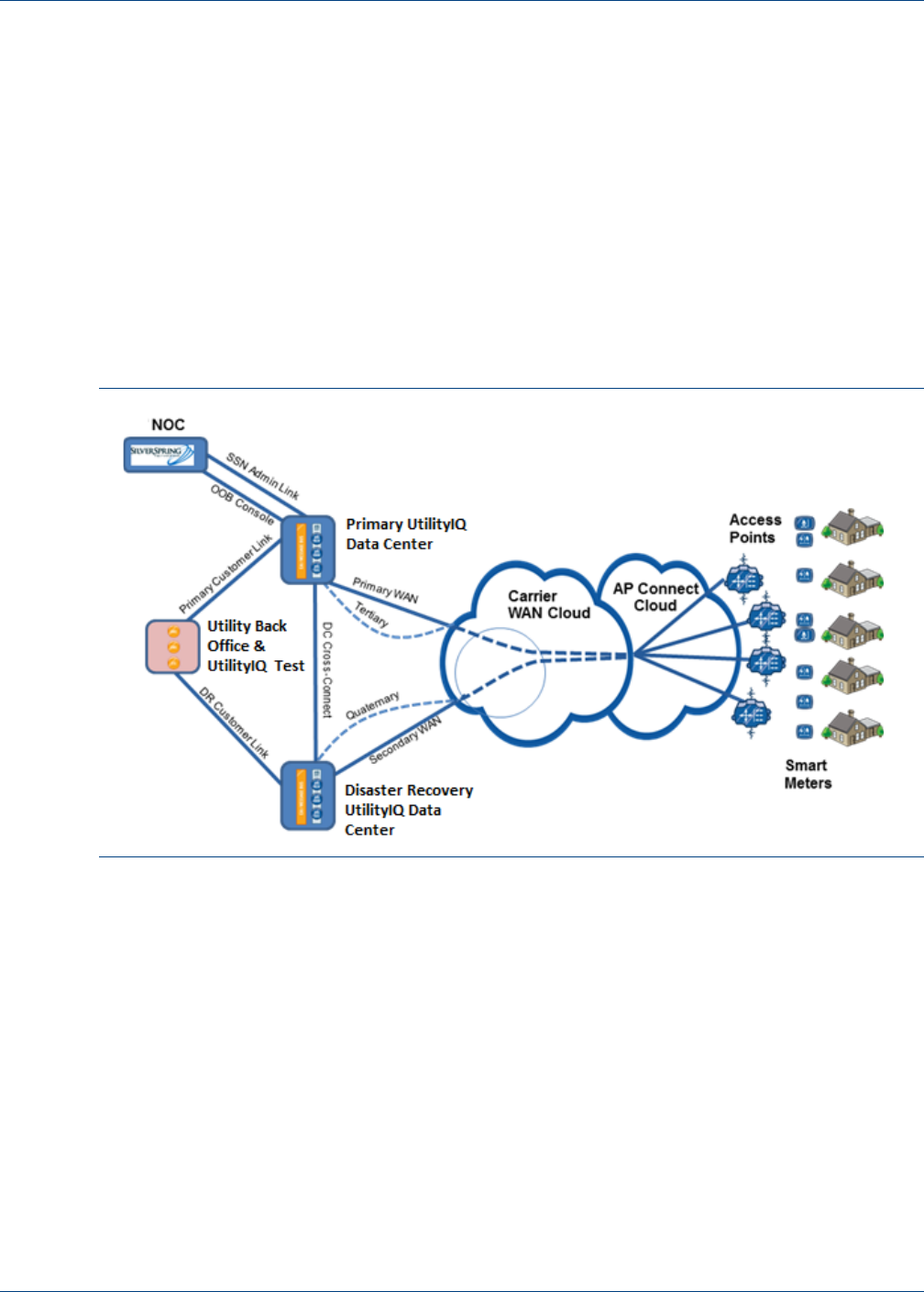
Understanding Silver Spring Networks Access Points 1 About Access Points
Understanding Silver Spring Networks Access Points 4 March 2013 Silver Spring Networks 4
1About Access Points
Overview
TheSilverSpringAccessPoint(AP)providesthecentrallinkbetweenendpointdevicesand
networkcontrolandmonitoring.Itistheconnectivitybetweenintelligentendpointsandthe
utility’sbackoffice.Itsflexiblecommunicationfeaturesextendthereachandcoverageofthe
networktothousandsofcustomerpremises,throughscalabilitythatlowersownershipcosts.
Sinceithasabackupbattery,theAPcanreliablyroutescheduledreadandmanagement
tasks,evenduringanoutage.Figure1illustrateshowAPsconnectendpointstotheutility
backoffice(UtilityIQdatacenters).
TheAccessPointcanbemountedonpowerpolesorstreetlamps.Alloutbound
communications(requestsfordata)passthroughtheAP.Allinbounddatapackets(data,
alarms)passthroughtheAP.
TheAPcanserveasthetake‐outpointfornetworkmanagementtrafficinastand‐alone
communicationnetwork(oralsoforAdvancedMeteringInfrastructure—AMI,Distribution
Automation—DA,orHANCommunicationsManager(HCM)—HCMtrafficinajoint
AMI/DA/HCMinstallation).Incertaincases,theAPcanbethetake‐outpointfortraffic.
ItisworthnotingthattheSilverSpringarchitecturediffersfrommostothersinthattheAPis
notwhatutilitycompaniestypicallycallacollectororconcentrator—itisarouter.This
meansthatmemorylimitsanddatavulnerabilityissuestypicalof“collector”architectureare
eliminatedresultinginamorerobust,scalable,simplerandhigherperformancenetwork.
TheAccessPointcomeswitha902‐928MHz‐basedradioNeighborhoodAreaNetwork(or
NAN)interfacewhichcanbeconfiguredwithanycellulartechnology(forexample,Code
Figure 1. The AP in the network

Understanding Silver Spring Networks Access Points 1 About Access Points
Understanding Silver Spring Networks Access Points 4 March 2013 Silver Spring Networks 5
DivisionMultipleAccess,LongTermEvolution,HighSpeedPacketAccess,singlecarrier
Radio Transmission Technology)WideAreaNetwork(WAN)interface,orwitha10/100
Ethernetinterface.TheAccessPointprovidesamethodforimplementingthelastmileutility
informationandcontrolnetwork.
Features
ThefeaturesoftheSilverSpringAccessPointare:
•Fulltwo‐way,870‐876and902‐928MHzFHSS
•One‐watttransmitter
•Dynamicnetworkdiscoveryandselfhealing
•Robustsecurityfromtheendpointthroughtothewideareanetwork
•“Over‐the‐air”networkfirmwareupgrades
•Sophisticatedroutingfunctionsensuremultiplepathstoeachendpoint
•Automatedschedulingandnetworkmanagementtasks
•Long‐reach,multi‐hopnetworks,providinghighendpoint‐to‐AccessPointdeployment
ratios
•Weather‐resistantoutdoorenclosure,forlongerlifeandgreaterdurability
•Batterybackupoption(highlyrecommended)forfault‐tolerantoperation
AP Product Description
ThetypesofAPsavailableare:
CellularAPs,SatelliteAPs,Pad‐mountAPs,andEthernetAPs.TheEthernetAPscanbe
configuredwith10/100BaseT,andFiberinterfaces.
CellularandEthernetAccessPointsareshippedpre‐configured.ForcellularAccessPoints,
SilverSpringwillworkwiththechosencellularprovidertofacilitateAccessPointturn‐up.
ForEthernetAccessPoints,SilverSpringwillworkwiththeclientonIPaddressingtoallow
SilverSpringtopre‐configurefielddevicesforquickfieldimplementation.
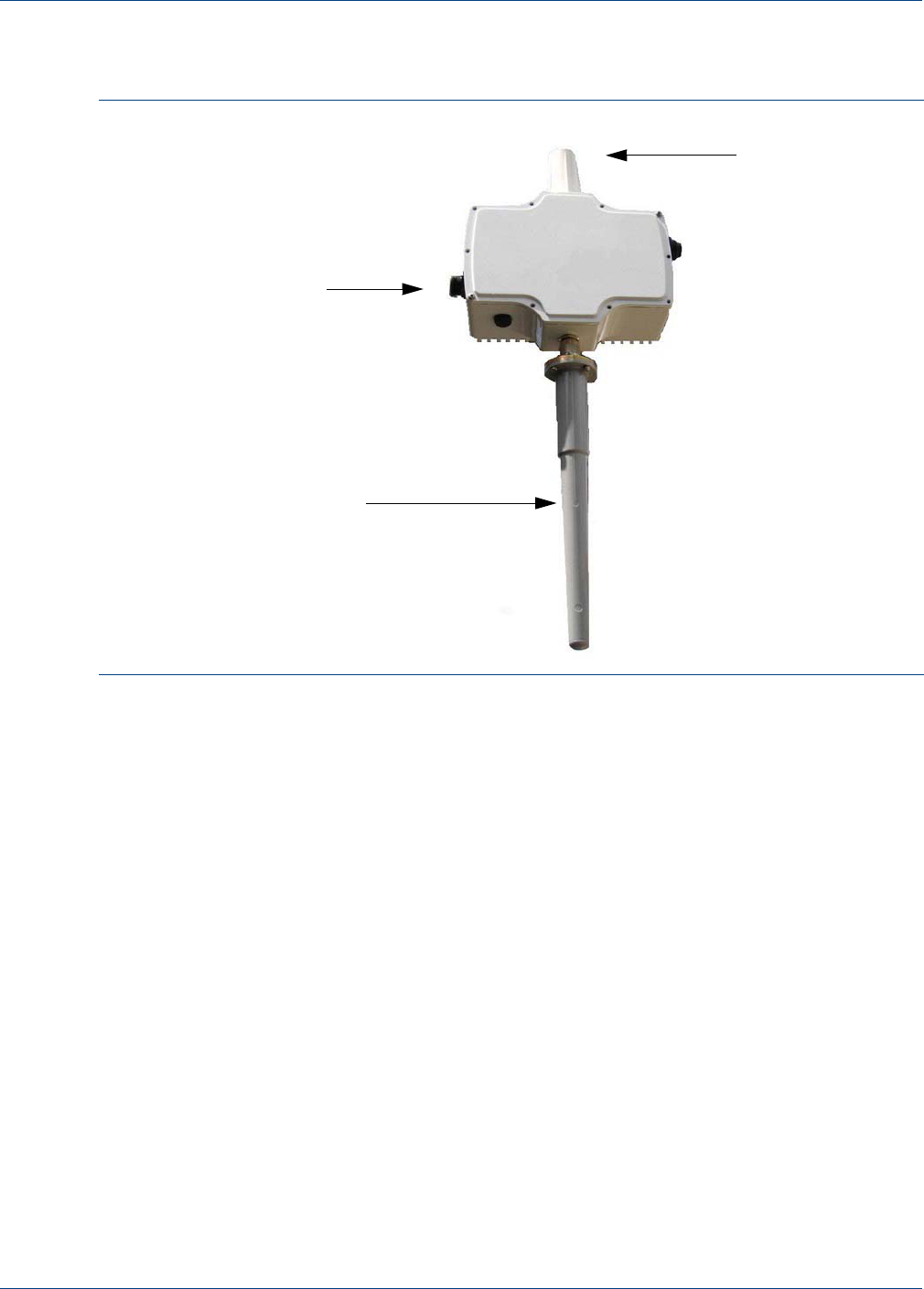
Understanding Silver Spring Networks Access Points 1 About Access Points
Understanding Silver Spring Networks Access Points 4 March 2013 Silver Spring Networks 6
Figure2showsanEthernetAP.
Battery Backups
APscanbeconfiguredwithbatterybackups.Intheeventofapowerfailure,thebattery
backupcanprovidecontinuousoperationforatleasteighthours.
SilverSpringNetworkssuggestsasabestpractice,abatterybackupwithintheAccessPoint.
Whenoperatingonbatterybackup,AccessPointsmaintainfulloperationalfeatures.The
InfrastructureBatteryPack(IBP)usessealedlead‐acidbatterytechnology,whichwilldeliver
energyovera‐40to+85Ctemperaturerange.SilverSpringoperatestheInfrastructure
BatteryPackonafloat(thatis,theusagemodelisdefinedaslongperiodsoftopped‐off
chargestatesfollowedbysporadicdeepdischargeevents(outageevents).
UtilityIQ®,GridScape,orHCMapplicationscanactivelymonitorstatus.Eventsrangein
severityfrominformational(forexample,exportjobsucceeded)towarning(forexample,the
gapfillerhasstartedrunningbecauseanintervalgapwasdetected),toerror(forexample,
theDCDetectionflagonthemeterwasset),toemergency.Theseincludeanalarmwhenthe
backupbatteryonanAccessPointiscriticallylow.
Formoreinformationonbatterybackupdevices,refertowww.enersys.com.Thekey
documentsare:
•CyclonApplicationManual
•CyclonSelectionGuide
Figure 2. Silver Spring Networks Access Point (AP)
Cellular antenna
Power
connector
NAN antenna

Understanding Silver Spring Networks Access Points 1 About Access Points
Understanding Silver Spring Networks Access Points 4 March 2013 Silver Spring Networks 7
ThedesignfloatlifeofSilverSpring‐IBPproductsisuptoeight(8)toten(10)yearsatroom
temperature(25°C/77°F)andunderproperchargingconditions.Thisdesignlifehasbeen
confirmedbytheuseofacceleratedtestingmethodsthatarewidelyacceptedbyboth
manufacturersandusersofsealed‐leadbatteries.Hightemperaturesareusedtoaccelerate
theagingprocessofthebatteryundertest.
Read Storage
TheAccessPointhas8MBofRAMand8MBofFlash.NoreadsarestoredwithintheAccess
Point.
Power Requirements
TheAccessPointandRelayrequire96to250VAC(50to60Hz).
Powercanbetappeddirectlyfromthepowerlineorfromastreetlightreceptacle.
Rebooting or Recycling APs
SilverSpringNetworksAPswillrunsteadystateforanindefiniteperiodoftime.Rebootsare
notcontingentuponanyinherenttendencyfortheAPtorebootitself.Theonlyconditions
thatwouldmanifestarebootare:
•Powerfailureintheabsenceofbatterybackup
•WANdialerreachesa“highwatercount”thatinducesafirmwarereboot–thishappens
whencellularcoverageisintermittent
•Upgradeoffirmware
•Deliberaterebootinstructionissuedfromfieldtechnicianorfromback‐office
Standards Compliance
APscomplywith:
•OperatingVibrationstandardANSIC12.20,IEC60068‐2‐8
•OperatingShockstandardANSIC12.20,IEC60068‐2‐27
•HumiditystandardANSIC12.20,IEC60068‐2‐6
•OperatingTemperaturestandardANSIC12.20,IEC60068‐2‐1,IEC60068‐2‐2
•ElectromagneticSusceptibilitystandardANSIC12.20,IEC61000‐4‐3
•SurgeWithstandCapabilitystandardANSIC12.20,IEC61000‐4‐5
•ElectrostaticDischargestandardANSIC12.20,IEC61000‐4‐2
•ElectricalFastTransientsperANSIC12.20,IEC61000‐4‐4
•ConductedImmunityperIEC61000‐4‐6
•MagneticImmunityIEC61000‐4‐8
•VoltageDips&InterruptsIEC61000‐4‐11
•SafetyStandardforInformationTechnologyEquipment,IEC60950‐1,IEC60950‐22
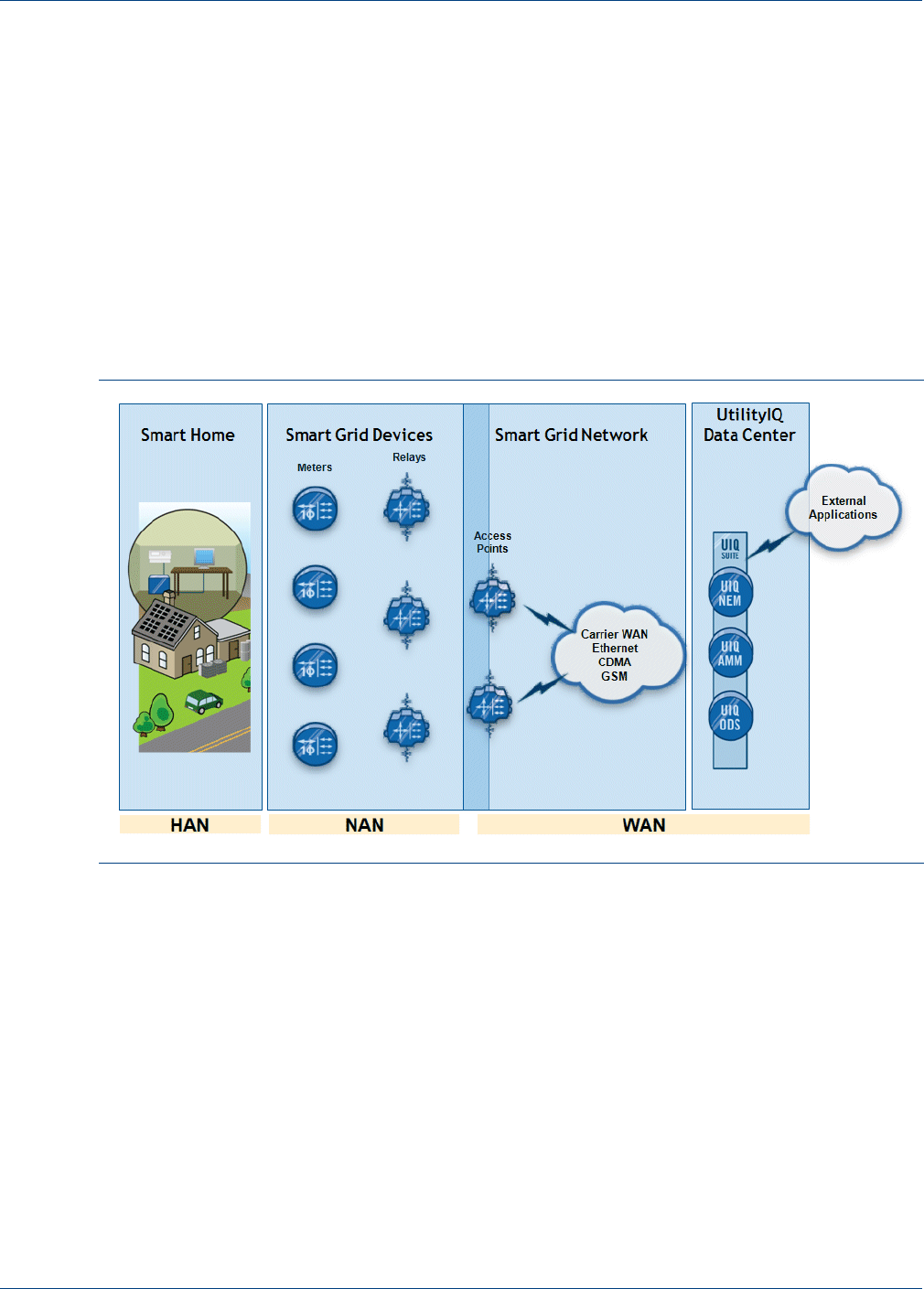
Understanding Silver Spring Networks Access Points 1 About Access Points
Understanding Silver Spring Networks Access Points 4 March 2013 Silver Spring Networks 8
Cellular Modem
Currently,themodemisaSierraWirelessAirLink,RavenX,RavenXT,orRavenXE
dependingonAPmodelandcountrylocation.
Addressing Schemes
SilverSpring’saddressingschemeisbasedontheInternetProtocol(IP)suite.Eachnetwork
devicehasoneormoreIPv6addresseswithintheLAN.TheAccessPointwilltypicallyhave
anIPv4addressassignedtotheWANside.A6in4tunnelcarriesthedataoveracellular
carrierorEthernet‐basedbackhaultotheheadend,wherethetunnelisterminated,andIPv6
trafficiscarriedthroughtoUtilityIQ,GridScape,orHCM.Ahigh‐levelconceptualizationof
theNAN‐to‐WANnetworksthatAPtraffictraversesisshowninFigure3.
TheAccessPointisthecentrallinkbetweentheutility’senterprisemanagementsystemsand
theendpointdevicessuchasSilverSpring‐enabledelectricity,water,gasmeters,bridges,
ExternalCommunicationsModules,andFaultCircuitIndicators.
TheAccessPointisavitalpartofthesmartgridnetwork,whichextendssecure,real‐time
measurementandcontrolinterfaces(withfull,two‐waycommunications)throughoutthe
networkandtothecustomerpremises.
TheAccessPointprovidesahighlyreliableconnectiontoRFdevicesoveraNAN.It
communicateswithintelligentendpoints,includingmetersandBridges.TheAccessPoint
canalsopassinformationthroughmultipleSilverSpringRelaysorthroughSilverSpring‐
enabledelectricitymetersorMasterBridges.Anditoffersmultiplepathstoeachendpoint,
throughsophisticatedmeshnetworkroutingthatensuresgreaterreliabilityandredundancy.
TheAccessPointalsoprovidesWANconnectivitytoyourutility’smission‐critical
applicationsthroughdigitalcellularorEthernetconnections.
Figure 3. APs in the Silver Spring Network

Understanding Silver Spring Networks Access Points 1 About Access Points
Understanding Silver Spring Networks Access Points 4 March 2013 Silver Spring Networks 9
Specifications
TheAPhardwarespecificationsarelistedinTable1.
Table 1. Access Point specifications
Feature Description
900-MHz Communications:
Data rate 100 - 300 Kbps
Frequencies 902-928 MHz North America
915-928 MHz Australia
902-907.5, 915-928 MHz Brazil
870-876 MHz Luxembourg & United Kingdom
870-873 MHz Portugal
922-928 MHz New Zealand
Spread Spectrum technology FHSS
Transmitter output 30 dBm
Output impedance 50 ohms
Receiver sensitivity -97 dBm for 1% PER
WAN Cellular, Ethernet, Satellite
Physical Interfaces:
Antenna connector N Type, Female
NAN antenna Omni antenna with gain not to exceed 3.6dBi on 2.4GHz and 6.0dBi
on 900MHz
Cellular antenna Mobile Mark antenna RMM-UMB-1S-WHT-7
Protocols/Security:
Addressing Internet Protocol Version 6 (IPv6)
Security Secure Hash Algorithm 256 bit (SHA-256) RSA-1024 and /or ECC-
256
Encryption AES-128 or AES-256
Mechanical:
Cellular 24cm (9.5”) L x 25cm (10”) W x 13cm (5.2”) H, 2.38kg (5.1 lbs.)
weight, IP65, white, aluminum housing
Ethernet 23cm (9”) L x 20cm (8”) W x 10cm (4”) H, 1.8kg (4 lbs.) weight, IP65,
white, aluminum housing
Underground (cellular) 34cm (13.5”) L x 29cm (11.5”) W x 15cm (6”) H, 6.2kg (13.6 lbs.)
weight, IP67, fiberglass reinforced polyester (FRP) housing
Environmental:
Operating Temperature: -40°C to +70°C (-40°F to +158°F)
Humidity: 0% to 95%, non-condensing
Power
Voltage Range: 96 to 250 VAC, ~ 1A, 50 to 60Hz

Understanding Silver Spring Networks Access Points 1 About Access Points
Understanding Silver Spring Networks Access Points 4 March 2013 Silver Spring Networks 10
European Union Compliance
ThissectiondescribesSilverSpringNetworks’compliancewiththeEUR&TTEDirective.
TheAccessPoint1.5iusesaoneWattFHSSradio.Licenseshavebeenissuedasfollows:
•Luxembourg
AlicensehasbeenobtainedfromILR(InstitutLuxembourgeoisdeRegulation)tooperate
inLuxembourginthe870‐876MHzband.
•UnitedKingdom
AlicensehasbeenobtainedfromOfcomtooperateinUKinthe870‐876MHzband.
•Portugal
AlicensehasbeenobtainedfromANACOMtooperateinPortugalinthe870‐873MHz
band.
Thisdevicehasbeendesignedtooperatewithandcertifiedforantennasthathavea
maximumgainof3.0dBion900MHz.Antennasthathaveagaingreaterthanspecifiedare
strictlyprohibitedforusewiththisdevice.Therequiredantennaimpedanceis50ohms.
Installationofallantennaradiatingelementsshallhaveaminimumseparationdistanceof20
cmfromallpersonsandmustnotbeco‐locatedoroperatinginconjunctionwithanyother
transmitter.
Declaration of Conformity with regard to the R&TTE Directive 1999/5/EC
Thisdeclarationisonlyvalidforconfigurations(combinationsofsoftware,firmware,and
hardware)providedandsupportedbySilverSpringNetworksInc.Theuseofsoftwareor
firmwarenotprovidedandsupportedbySilverSpringNetworksInc.mayresultinthe
equipmentnolongerbeingcompliantwiththeregulatoryrequirements.
Power Consumption Idle Maximum
Ethernet 2.5W, 7W
Ethernet with battery 2.5W, 8W
Cellular 2.5W, 12.5W
Cellular with battery 2.5W, 13.5W
Battery Backup Option: > 8 hour operation
Receive Sensitivity Receive sensitivity is -102 dBm @ 10-6 BER.
Mounting Kit Options:
Pole Wooden, concrete, light
Other Wall, pad
Approvals:
FCC Part 15.247
Industry Canada RSS-210
Table 1. Access Point specifications (Continued)
Feature Description

Understanding Silver Spring Networks Access Points 1 About Access Points
Understanding Silver Spring Networks Access Points 4 March 2013 Silver Spring Networks 11
Note: The equipment is in compliance with the essential requirements and other relevant
provisions of Directive 1999/5/EC.
Thefollowingstandardswereapplied:
•EMC: EN55022(2010),EN55024(2010),EN61000‐3‐2(2006)
EN61000‐3‐3(2008),ETSIEN301489‐3v1.4.1
•Safety: EN60950‐1:2006,EN60950‐22:2006,BS‐EN62311(2008)
•Radio: ETSIEN300220‐1v2.3.1(2010‐02),ETSIEN300220‐2v2.3.1(2009‐12),
TheconformityassessmentprocedurereferredtoinArticle10anddetailedinAnnexIVof
Directive1999/5/EChasbeenfollowed.
Note: This equipment is intended to be used in Luxembourg, United Kingdom, and Portugal in
conjunction with licenses. For more details, contact Silver Spring Networks Compliance.
TheproductcarriestheCEMark:
AcopyoftheDeclarationofConformitymaybeobtainedwithformalrequestto:
SilverSpringNetworks,c/oHardwareEngineering
555BroadwayStreet
RedwoodCity,CA94063,USA
Declaration of Conformity for RF Exposure
ThissystemhasbeenevaluatedforRFexposureforHumansinreferencetoEN62311(2008)
Assessmentofelectronicandelectricalequipmentrelatedtohumanexposurerestrictionsfor
electromagneticfields(0Hz–300GHz).Theminimumseparationdistancefromtheantenna
togeneralbystanderis20cm(7.9inches).
Installation Note
SinceAPsdonothaveapoweron/offswitchfordisconnectingACpowerbeforeservicing,
ACpowerisprovidedthroughanACmainsdisconnectswitchorbreaker.Therefore,the
electricalinstallationofthisproductisunderthecontrolofthepowerutilitiesortheir
authorizedsubcontractors.Refertotheirproceduresforfurtherinstructions.
Onlycertaintypesofbatteriescanbeusedforbatteryreplacements.ContactSilverSpring
Networksforinformationaboutequivalentbatterytypesthatcanbeusedforreplacement.
Maintenance Procedures
IfanAccessPointexperiencesanoutage,allendpointdevicesandRelaysthatwere
associatedwithitwillconvergeontheirsecondaryAccessPointasfoundwithintheir
NodeQs.ThisalleviatesoutagesduetoAccessPointfailure.UtilityIQ‐NetworkElement
Manager(NEM),GridScape,orHCMisthenalertedofanAccessPointoutage,andforwards

Understanding Silver Spring Networks Access Points 1 About Access Points
Understanding Silver Spring Networks Access Points 4 March 2013 Silver Spring Networks 12
thismessagetotheoperator.Sparepre‐configuredAccessPointsarekeptonhand,andare
scheduledfornetworkinsertionwithintheutilitiesworkordermanagementsystem.Within
NEM,GridScape,orHCM,thefailedAccessPointisflaggedforRMA,andthedeviceis
replaced.
Surge Protection
APscomplywithupto20kVforcombinationwaveandupto6kVforringwaves(reflectsthe
currentEthernetAPandprojectedassembly.)
Redundant WAN Option
WANredundancyisinherenttotheroutedMeshbeingofferedbySilverSpringNetworks.
AccessPointshavetheabilitytoidentifyWANoutagesandforwardtraffictosecondary
AccessPointsthroughtheir902‐928FHSSinterface.Thereisnodowntimerealizedandas
routestotheWANbecomeunavailable,thoseroutesageoutoftheroutetablesofadjacent
nodesaswouldbeexpectedinafull‐meshnetworkthatcontinuouslyupdatesnodequeues
androutetables.WhenanAPbecomesunavailable,theroutedMeshdynamically
reconfigurestoavailableAPs.WhentheAPcomesbackonline,theroutedMeshdynamically
reconfigurestoincludetheAPintheMeshnetwork.
ItisthesuggestionofSilverSpringthatmultiplecellularcarriersbespreadacrossthe
territorytoreducetheimpactofawidescalecellularoutage.Inaddition,theco‐minglingof
privatebackhaulsuchasprivatenetworkfoundwithinsubstationsisalsoanoption.The
SilverSpringNetworksAccessPointcanusepublicorprivatebackhaultechnologiesto
communicatetothehostsystem(UtilityIQ,GridScape,orHCM)attheUtilityheadend.An
APcanhaveacellularmodem(suchasthoseapprovedforuseonCDMAorGeneralPacket
RadioService(GPRS)systemsfromSprint,AT&T,Telusorothercarrier)oranybroadband
technologythatisEthernet/IPcompatible(suchasWi‐Fi,fiber,privatemicrowaveor
WiMAX).CurrentSilverSpiringcustomersareusingcellularmodems,fiberbackhaul,and
privatelicensedandunlicensedwirelessbackhaultechnologies.Additionally,some
customersarecurrentlyexperimentingwithsatellitebackhaulconnectionsandwillbe
deployingthistechnologywhereneeded.
Mounting Options
TheAccessPointscanbemountedonautilitypoleorlightpole.Thecanbepadmountedas
wellaswallmounted.(Foradditionalinformation,refertotheSilverSpringNetworks
InfrastructureHardwareGuide.)SilverSpringrecommendsthattheunitsbemountedata
heightof7to9meters.
WAN Options
AnyWANbackhaulthatcaninterfacewiththeAccessPoint’sEthernetportandprovide
IPv4connectivitytotheHESwithaminimumof40kbpscanbeusedasbackhaul.
Customershaveusedthefollowingalternativebackhaultechnologies:
•DistributionSubstationBackhaul(forexample,fiber)
•WiMAX
•SatelliteRadios

Understanding Silver Spring Networks Access Points 1 About Access Points
Understanding Silver Spring Networks Access Points 4 March 2013 Silver Spring Networks 13
ThedesignruleforAccessPointtoRFdevicesis1to5,000.Atthisratio,themaximumdata
throughputrequiredfromaWANsolutionis40kbpsperAccessPoint.
Basedonreal‐worlddataonanetworkofthissize,theaveragewirelessspeedismeasuredat
2.6Mbpsdownstreamand700Kbpsupstream,whichiswellinexcessofrequirements.
Thebackhaulisfairlyinsensitivetolatency(thatis,inremotelocations,SilverSpringalready
provensuccessfulconnectionusingsatelliteradioswhichhavea~1.5sRTT‐orRoundTrip
Time).
SilverSpringrecommendsthatthenetworkdesignforaparticulardeploymentlimit
exposuretosinglepointsoffailureandproactivelydesignforredundancybyallowingeach
RFdevicetobereachedfrommorethanoneAccessPoint.Inallbutruraldensities,having
upto5,000RFdevicesperAPgenerallyresultsinmostRFdevicesbeingabletoreachmore
thanoneAccessPoint.
Throughput Performance
TypicaldatapacketsizesobservedinSmartGridsystemsisbetween150bytesforDAor
othersimplecommandandcontrolapplications.AnormalHCMandAMImeterreadpacket
isapproximately350bytesincludingfullmeasurementintervals,eventlogs,and
instantaneousregisterreads.At100Kbps(10bytes/ms),deliveryof150bytepacketsoccurs
at10fulltransactionspersecond.
ThelargerAMI/HCMpacketsaredeliveredat3‐5transactionspersecond.Thesearetypical
observedratesanditshouldbementionedthatforreliabilityreasonsalltransactionsare
completelyacknowledgedfour‐wayconfirmedevents.
Thoughfinaldataisnotavailable,raisingon‐airdataratesfrom100Kbpsto300Kbpswill
roughlydoublethePPSratesattheaggregationpoints(AccessPoints).Thismovesthedaily
capacityofanAccessPointfromapproximately400,000transactionsperdaytonearlya
million.
ThebandwidthbeingfedtotheWANsideoftheAccessPointisdeterminedbywhat
backhaulisbeingused.
WiththeAccessPointbeingarouterandnotacollector,dataisconstantlybeingtransmitted
throughtheWAN,eliminatingtheneedtostoredataforlatertransmission(Storeand
Forward).TheAccessPoint,using100KbpsontheNANside,aggregates3000‐5000meters,
bridges,orotherRFdevices,whileprocessingapproximately5transactionspersecondand
deliveringupwardsof500,000transactionsperdaytothebackoffice.
TherawthroughputintheRFNANintheSilverSpringsmartgridsolutionis100Kbps
node‐to‐node.Thismeansthatbetweeneachdevice,thereis100Kbpsofavailable
bandwidth.Onaverage,theamountoftrafficisrelativelylowwithrespecttotheamountof
availablebandwidth.
Figure4illustratesdatacollectedfromalivecustomernetworkoveraperiodofoneweek.
Asshown,theaveragebandwidthconsumedbyAdvancedMeteringtrafficisapproximately
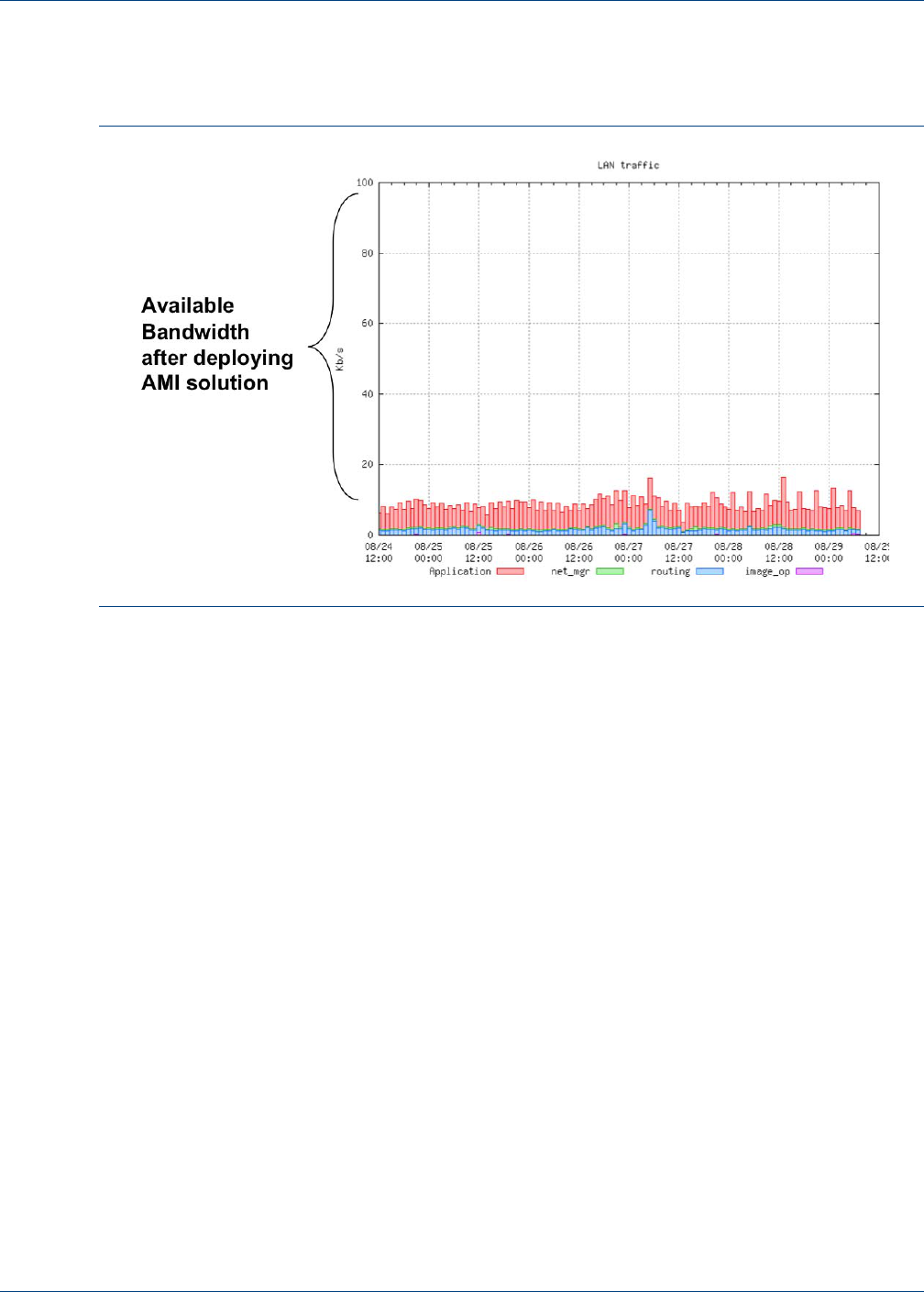
Understanding Silver Spring Networks Access Points 1 About Access Points
Understanding Silver Spring Networks Access Points 4 March 2013 Silver Spring Networks 14
15Kbpsor15%,leaving85%forothersmartgridsolutionssuchasDAorDR(disaster
recovery).
ItisworthnotingthatthereareanumberoffactorsthatimpacteachRFMeshlinkbetween
anytwonodesincludingbutnotlimitedto:scheduledjobs(suchasmeterreads),path
selectionfromanRFdevicetoanAccessPoint,failuresoroutages,etc.Aneffectivemethod
tomonitornetworkperformance(datatransmission,bandwidthutilization,etc.)isatan
AccessPointastheAPisthetakeoutpointforallassociatedRFdevices.MeaningRFdevices
andRelaysintheSilverSpringNANareconstantlyretuningto,optimizingtheirpathsand
reportingintotheirAccessPoints.
AlltrafficflowinginandoutoftheRFMeshnetworkmusttraversetheAccessPoint.Whileit
isfairlysimpletomonitorasingleAccessPoint,itisimportanttorealizethatthereare
typicallymanyAccessPointsinacommerciallydeployedsmartgridsystem.TheSilver
SpringsolutionenablesallAccessPointstooperateindependentlyandinparallel,effectively
increasingthroughputandreducinglatency.
TheSilverSpringUtilityIQNEM,GridScape,andHCMenabletheconfigurationofpolices
forbandwidthutilizationforboththeWANandtheNAN.Onceconfigured,themonitoring
applicationsgeneratealertsforanybandwidthutilizationpolicyviolations.Thenetwork
statisticsreportprovidesdetailedinsightintopotentialnetworkloadissues.
ThemonitoringapplicationscanmeasureandreportonRFcharacteristicsintheNAN,
includingtheidentificationofdevicesassociatedwithareasofpoorcoverage.Havingsuch
dataenablesSilverSpringtoassesswhethersuchareasrequirethedeploymentofadditional
RelaysorAccessPoints.Thisisespeciallyusefulintheearlyphasesofadeployment.
Figure 4. Average bandwidth consumed by AMI traffic
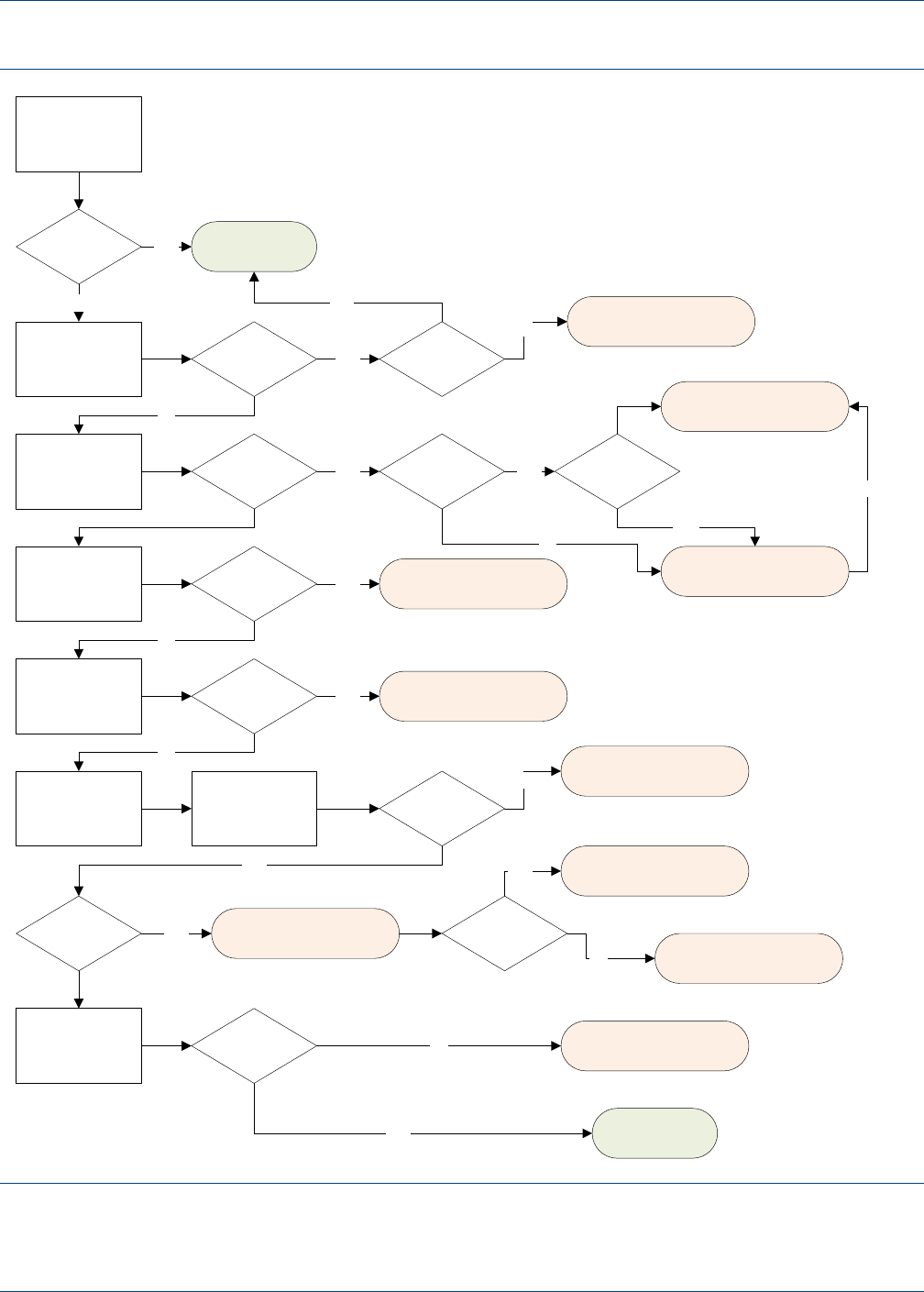
Understanding Silver Spring Networks Access Points 1 About Access Points
Understanding Silver Spring Networks Access Points 4 March 2013 Silver Spring Networks 15
Figure 5. AP Failure management
1
Alert Recieved
2
Alert
Cleared?
3
Ping the IPv6
Address of the AP
4
IPv6 reachable ?
5
Alert
Cleared?
6
Ping the IPv4
Address of the AP
7
IPv4
reachable?
8
B/D O
AP?
9
Use Wireless
ACE utility to
isolate Problem
10
Traceroute to the
IPv4 Address of the
AP
11 Traceroute
terminates inside
L42?
12
From a remote
server ping the IPv4
address of AP
13
IPv4
reachable?
14
Identify Neighbouring
Devices
16
AP Seen in
neighbour
NodeQ?
15
Check NodeQ of
neighbours
17
Is reboot counter
increasing?
18
Attempt to reboot
Manually
19
Manual reboot
resolve?
20
Carrier Network
OK
Stop
Problem with Event Monitoring –
Call IT
Stop
Problem with AP Hardware –
Call Field Engineer
Problem with WAN Network –
Call WAN Carrier Problem with WAN Network –
Wait for resolution
Problem with AP Hardware –
Call Field Engineer
Problem with AP Hardware –
Call Field Engineer
Problem with AP Hardware –
Call Field Engineer
Problem with 6in4 tunnel – Call
IT
Problem with BO Network – Call
IT
Problem with BO Network – Call
IT
No
Yes
Yes
Yes
No
No
Yes Yes
AP
6in4
Yes
No
Yes
No
No
Yes
Yes
Yes
No
No
Yes
No

Understanding Silver Spring Networks Access Points 1 About Access Points
Understanding Silver Spring Networks Access Points 4 March 2013 Silver Spring Networks 16
Responding to a WAN Failure
AnAPmightnotbereachablebecausethedevicecannotdialoutontheWAN.Thedevice
continuestotrydialingoutuntilitiseitherabletoconnect,orithasdialed308times.Ifitcan
connect,thedevicenotifiestheeventmanagementprogramthatithassuccessfully
recovered.Ifitcannot,thenthemodemresetsitself.ThebehaviorofanAPrepeatedly
becomingunreachable,andthenrecoveringshortlyafter,iscalledflapping.
Asmallamountofflappingisnormal.Becauseadevicecanrecoveronitsown,waitforone
dayofdowntime,oronetotwodaysoffrequentflappingbeforeinvestigatingfurther.
Filteringandreviewingtheeventmanagementprogrammailalertsregularlycanhelpto
identifydevicesthatneedattention.Thestandardoperatingprocedureregardingcollector
failure/managementisshowninFigure5onpage15.
Multicast / Unicast Communications
Commandssentfromhead‐endmonitoringapplications(NEM,GridScape,orHCM)
throughtheAccessPoint(AP)areunicast,asthereceiptofeachpacketmustbe
acknowledged.However,insimilarfashiontomulticast,commandscanbesenttoa
staticallyordynamicallydefinedgroupofRFdevicesforeaseofmanageability.Inaddition,
theHESsends“Jobs”outinparalleltoAccessPoints,thattheninturn,sendcommandsout
toendpoints.Theresultingeffectisparallelprocessingthataccomplishesamulticast‐like
service.
Networking
EachNICinSilverSpringRFdevicesregisterswithtwoIPv6addresses–oneforeachoftwo
APs:aprimaryandsecondaryAP.Whenonedies,anotherisfound.Fromatopology
perspective,eachAPisitsownIPv6subnet.SoNICsareintwodifferentsubnets‐onefor
eachAP.
Theend‐to‐endprotocolwithintheNANisAES128/256bit,cryptoIPv6.AstheAccessPoint
understandsthefulltopologyoftheunderlyingmesh,theIPv6packetissourceroutedfrom
theAPtoeachenddevice–meaningthatthefullcommunicationpathfromtheAccessPoint
tothedeviceisspecified,hopbyhop,inthepacket.TheNANendpointtoAccessPoint
routingdecisionsaremadehop‐by‐hop(thatis,theNANendpointwillsendtheIPv6packet
toitsneighborthathastheleastcostroutetotheAccessPoint.Thenthisneighborwill
forwardthepackettoitsneighborwiththebestrouteuntilthepacketreachestheAccess
Point.(TheAccessPointacquiresitsunderstandingofthefullmeshtopologybecauseit
sendsrouteadvertisementmessagesatrandomizedintervals.)
NANsystemonewaylatencyismeasuredat50msperhopbetweenanypointsintheNAN.
TheSilverSpringnetworkdesignexpectsonaverage,nomorethan6hopstoanyendpoint
(suchasameterorDataLinkControl,DLC,device).Thiswouldtypicallyyield300msof
NANlatencytoanyRForDLCdevice.Inaddition,anAccessPointcanprocessupto10
packetspersecond.EachDLCcommandconsistsofasinglepacket,withoneassociated
ACKpacket.WithnootherAMItraffictraversinganAccessPoint,anAccessPointcould
process100DLCcommandsandACKs,inapproximately30seconds.
Thecellularmodemhasstore‐and‐forwardGPSreportingcapabilitywithaccuracynoless
than10meters.
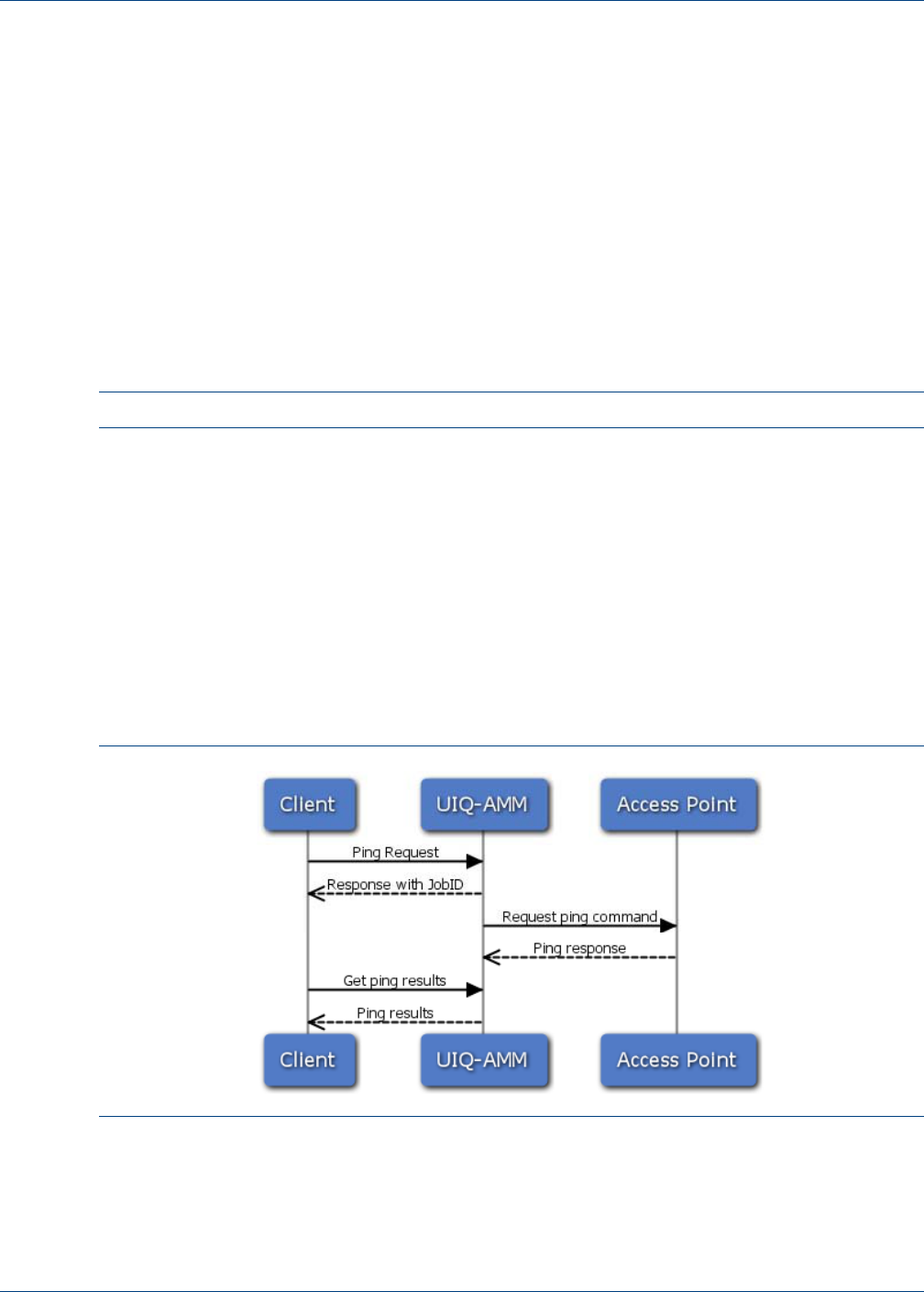
Understanding Silver Spring Networks Access Points 1 About Access Points
Understanding Silver Spring Networks Access Points 4 March 2013 Silver Spring Networks 17
Address Management
FortheLAN,aDDNS(DynamicDNS)systemisused.EachdevicehasoneormoreIPv6
addressedassignedtoit,basedonitslocationinthenetworkandrouteoutoftheLAN.
Theseaddressesarethenstoredattheheadendandusedforallcommunicationswiththe
devices(ping,trace,reads,etc.),givingthecustomeratrue,nativeend‐to‐endIPnetwork.
Administration
ThissectiondiscussesadministrativeissuesaboutAccessPoints.
TheRavenXmodemineachAPhasaTELNETportthatisusedforinternalcommunications
supportpurposes.TheRavenXmodemontheAPusesport6543forTELNET.Donotdisable
thisportasdoingsowillpreventtheSierraWirelessapplicationfromcommunicating.
Note: Silver Spring does not support end users accessing the AP’s modem TELNET port.
Justlikeameter,itispossibletopinganAccessPoint.TheSilverSpringsolutionusesIPv6,
soitissimplyamatterofinvokinganon‐demandping.Thiscanbeaccomplishedthrough
theUtilityIQ‐AMMuserinterface,throughwebservices,throughGridScape,orthrough
HCM.
YoushouldgettwopingresponsesforeachAP.OneisfromtheRavenXmodem.Theother
isfromtheNICintheAP.
Toinvokeanon‐demandpingagainstanAccessPoint,navigatetotheappropriateDevice
DetailspageandclickontheOnDemandPinglink(locationvarieswitheachmonitor
application).Figure6illustratesthepingsequenceforUtilityIQ’sAMMapplication.
Also,UtilityIQAMMexposesawebservicesAPIforinvokingon‐demandpingsagainst
AccessPoints.
Figure 6. Ping sequence

Understanding Silver Spring Networks Access Points 1 About Access Points
Understanding Silver Spring Networks Access Points 4 March 2013 Silver Spring Networks 18
Configuration
Tofacilitatetheconfigurationandremovethechanceforhumanerror(forexample,typos)a
simpleshellscriptisgeneratedandrunfromaUNIX‐basedlaptopwhichhasaSilverSpring
FieldServiceUnitattachedtotheUSBport.
Note: All Silver Spring APs are configured during the manufacturing process to ensure that
the proper profile (Network ID, etc.) is included. Additionally, the software tool, net_mgr,
required to configure an AP, is not a user facing tool.

Understanding Silver Spring Networks Access Points 2 FCC and Government Guidelines
Understanding Silver Spring Networks Access Points 4 March 2013 Silver Spring Networks 19
2FCC and Government Guidelines
Silver Spring Networks NIC
FCC ID: OWS-NIC44 IC: 5975A-NIC44 M/N: NIC44
TheAP/RelayNICisREQUIREDtobeprofessionallyinstalledbyaproperlytrained
technician.Improperinstallationcouldvoidtheuserʹsauthoritytooperatetheequipment.
ThedevicecomplieswithPart15oftheFCCrules.Operationissubjecttothefollowingtwo
conditions:
1. Thedevicemaynotcauseharmfulinterference.
2. Thedevicemustacceptanyinterferencereceived,includinginterferencethatmaycause
undesiredoperation.
Theantennaofthistransmittermustnotbeco‐locatedoroperatinginconjunctionwithany
otherantennaortransmitter.
Thedeviceshouldbeinstalledsothatpeoplewillnotcomewithin23cm(9in.)ofthe
antenna.
ThisequipmenthasbeentestedandfoundtocomplywithPart15oftheFCCRules.This
equipmentgenerates,uses,andcanradiateradiofrequencyenergy,andifnotinstalledand
usedinaccordancewiththeinstructions,maycauseharmfulinterferencetoradio
communications.However,thereisnoguaranteethatinterferencewillnotoccurina
particularinstallation.Ifthisequipmentdoescauseharmfulinterferencetoradioor
televisionreception(whichcanbedeterminedbyturningtheequipmentoffandon),theuser
isencouragedtotrytocorrecttheinterferencebyoneormoreofthefollowingmeasures:
•Reorientorrelocatethereceivingantenna.
•Increasetheseparationbetweentheequipmentandreceiver.
•Connecttheequipmentintoanoutletonacircuitdifferentfromthattowhichthereceiver
disconnected.
•Consultthedealeroranexperiencedradio/TVtechnicianforhelp.
Figure 7. Sample FCC ID label for NIC PCA
AP,44,ETHERNET,USA
Catalog#200‐040001
FCCID:OWS‐NIC44IC:5975A‐NIC44
ModelNo.:NIC44
ThisdevicecomplieswithPart15oftheFCCRules.
Operationissubjecttothefollowingtwoconditions:(1)this
devicemaynotcauseharmfulinterferenceand(2)thisdevice
mustacceptanyinterferencereceived,includinginterference
thatmaycauseundesiredoperation.
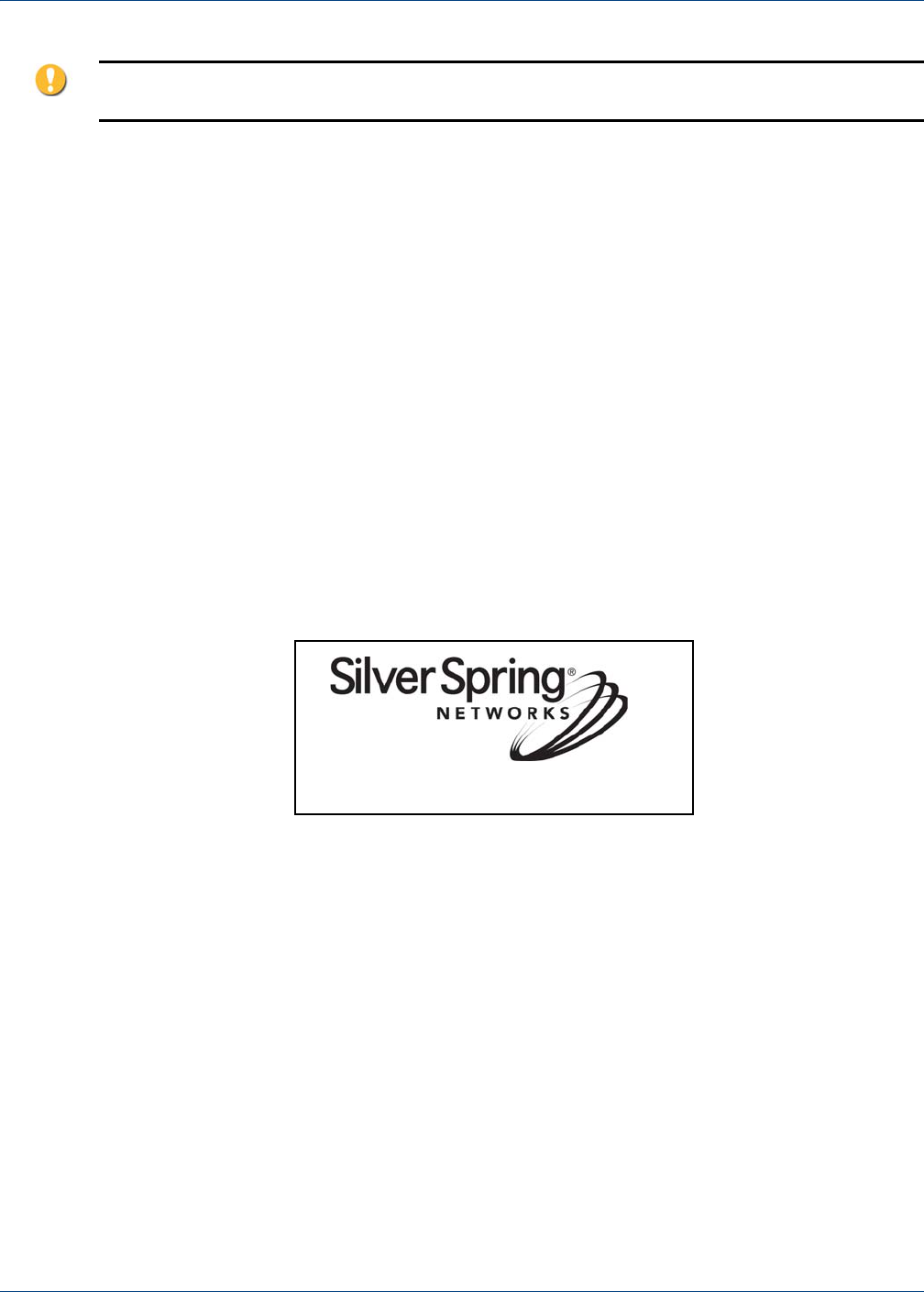
Understanding Silver Spring Networks Access Points 2 FCC and Government Guidelines
Understanding Silver Spring Networks Access Points 4 March 2013 Silver Spring Networks 20
FCC Guidelines for Devices Containing a Transmitter Module
ThefollowingisanextractfromFCCPART15UNLICENSEDMODULARTRANSMITTER
APPROVAL,DA00‐1407,Released:June26,2000,Section6describinglabelingrequirements
fordevicescontainingamodulartransmitter.
Section6.ThemodulartransmittermustbelabeledwithitsownFCCIDnumber,and,if
theFCCIDisnotvisiblewhenthemoduleisinstalledinsideanotherdevice,thenthe
outsideofthedeviceintowhichthemoduleisinstalledmustalsodisplayalabel
referringtotheenclosedmodule.Thisexteriorlabelcanusewordingsuchasthe
following:“ContainsTransmitterModuleFCCID:XYZMODEL1”or“ContainsFCCID:
XYZMODEL1.”Anysimilarwordingthatexpressesthesamemeaningmaybeused.The
Granteemayeitherprovidesuchalabel,anexampleofwhichmustbeincludedinthe
applicationforequipmentauthorization,or,mustprovideadequateinstructionsalong
withthemodulewhichexplainthisrequirement.
Inthelattercase,acopyoftheseinstructionsmustbeincludedintheapplicationfor
equipmentauthorization.
Industry Canada Guidelines for Devices Containing a Transmitter
Module
For All Radio Transmitters
Thisradiotransmitter5975A‐NIC44hasbeenapprovedbyIndustryCanadatooperatewith
theantennatypeslistedbelowwiththemaximumpermissiblegainandrequiredantenna
impedanceforeachantennatypeindicated.Antennatypesnotincludedinthislist,havinga
gaingreaterthanthemaximumgainindicatedforthattype,arestrictlyprohibitedforuse
withthisdevice.
Antenneomnidirectionnelle,3.0dBisur900MHzet2,4GHzsur3.6dBi
Leprésentémetteurradio(identifierledispositifparsonnumérodecertificationouson
numérodemodèlesʹilfaitpartiedumatérieldecatégorieI)aétéapprouvéparIndustrie
Canadapourfonctionneraveclestypesdʹantenneénumérésci‐dessousetayantungain
CAUTION: Changes or modifications not expressly approved by Silver Spring Networks could void
the user's authority to operate the equipment.
Figure 8. Sample FCC ID label for devices containing a NIC
Contains FCC ID: WWWXXXXX IC:YYYYY-XXXX
M/N: ZZZZZ

Understanding Silver Spring Networks Access Points 2 FCC and Government Guidelines
Understanding Silver Spring Networks Access Points 4 March 2013 Silver Spring Networks 21
admissiblemaximaletlʹimpédancerequisepourchaquetypedʹantenne.Lestypesdʹantenne
noninclusdanscetteliste,oudontlegainestsupérieuraugainmaximalindiqué,sont
strictementinterditspourlʹexploitationdelʹémeeur.
UnderIndustryCanadaregulations,thisradiotransmittermayonlyoperateusingan
antennaofatypeandmaximum(orlesser)gainapprovedforthetransmitterbyIndustry
Canada.Toreducepotentialradiointerferencetootherusers,theantennatypeanditsgain
shouldbesochosenthattheequivalentisotropicallyradiatedpower(e.i.r.p.)isnotmore
thanthatnecessaryforsuccessfulcommunication.
ConformémentàlaréglementationdʹIndustrieCanada,leprésentémetteurradiopeut
fonctionneravecuneantennedʹuntypeetdʹungainmaximal(ouinférieur)approuvépour
lʹémetteurparIndustrieCanada.Danslebutderéduirelesrisquesdebrouillage
radioélectriqueàlʹintentiondesautresutilisateurs,ilfautchoisirletypedʹantenneetson
gaindesortequelapuissanceisotroperayonnéeéquivalente(p.i.r.e.)nedépassepas
lʹintensiténécessaireàlʹétablissementdʹunecommunicationsatisfaisante.
For Transmitters Not Requiring Licenses
ThisdevicecomplieswithIndustryCanadalicence‐exemptRSSstandard(s).Operationis
subjecttothefollowingtwoconditions:(1)thisdevicemaynotcauseinterference,and(2)
thisdevicemustacceptanyinterference,includinginterferencethatmaycauseundesired
operationofthedevice.
LeprésentappareilestconformeauxCNRdʹIndustrieCanadaapplicablesauxappareils
radioexemptsdelicence.Lʹexploitationestautoriséeauxdeuxconditionssuivantes:(1)
lʹappareilnedoitpasproduiredebrouillage,et(2)lʹutilisateurdelʹappareildoitacceptertout
brouillageradioélectriquesubi,mêmesilebrouillageestsusceptibledʹencompromettrele
fonctionnement.
Safety Information
Carefulplanningofeveryjobisessential.Nothingshouldbetakenforgranted.Donottake
chances!
•Readandfollowallapprovedpoliciesandproceduresprovidedbyyouremployer
associatedwiththeproceduresinthismanual.
•Theproceduresinthismanualmustonlybeperformedbyqualifiedworkersin
accordancewithlocalutilitysafetypractices,utilityrequirements,andapplicableOSHA
andNFPAstandards.
WARNING: Severe shock and explosion hazard! Touching energized parts can result in
massive equipment damage, and severe injury or death. Short-circuiting energized parts will
result in blinding flash and explosion. Opening and closing electrical circuits can also produce
dangerous and explosive arc flashes. Involuntary muscular reactions associated with electrical
shock may result in other injuries. Observe the following safety guidelines.

Understanding Silver Spring Networks Access Points 2 FCC and Government Guidelines
Understanding Silver Spring Networks Access Points 4 March 2013 Silver Spring Networks 22
•Theinformationcontainedinthisdocumentisintendedtoaidqualifiedpersonnel,andis
notareplacementforthepropertrainingrequiredtomakeapersonqualified.
•SilverSpringNetworksassumesnoliabilityforthecustomerʹsfailuretofollowthese
safetyguidelines.
General Electrical Safety
•Performtheproceduresinthismanualinaccordancewithapplicableworkplace
standardsestablishedbythefollowingagencies:
— OccupationalSafetyandHealthAct(OSHA).
—TheNationalElectricalCodepublishedbytheNationalFireProtectionAssociation
(NFPA‐70).
—NationalElectricalManufacturersAssociation(NEMA).
— ElectronicsIndustriesAssociation(EIA).
—InsulatedPowerCableEngineersAssociation(IPCEA).
•AmericanNationalStandardsInstitute(ANSI).Wheneverpossible,de‐energizeall
circuitsorequipmentbeforeworkingonthem.
•Maintainaminimumclearanceof10feet(3meters)betweenlinepotentialandall
unqualifiedpersonsatalltimes.
•Keepunauthorizedpeopleoutoftheworkarea.Beespeciallycautiousofchildren,who
tendtobedrawntoworkactivity.
•DeterminingifacircuitisOFFcanbedifficultinsomeinstances.Checkforcircuitvoltage
withanappropriatevoltmeterbeforeworkingonequipmentpresumedtohavebeen
de‐energized.Tiebreakers,doublethrowdisconnectswitches,automatictransfer
switchesandemergencygeneratorscansupplypowerthroughanalternatecircuitor
fromanothersource.
•120Vcurrentcanbejustalethalashighervoltagesbecausecurrentflowthroughabody
dependsuponthebodyʹsresistance.
•Donottrustinsulationand/orweatherproofingonawireasprotectionfromshock.
•Useelectricallyinsulatedtools.Inspectportableelectricalequipmentortoolsfordefects
andremoveanydefectivedevicesfromserviceimmediately.Allportableelectrical
equipmentmusthaveGroundFaultCircuitInterrupter(GFCI)protection.
•Selecttherighttoolforthejob.Usetoolsproperly.Keeptoolsingoodworkingorder.
•Makesuretheworkareaisfreeofanyflammablematerial.Flammablevaporscanbe
ignitedbyanarcflash.
•Keeptheworkareacleananddry.Clutteredworkareascauseaccidentsandinjuries.
•Providegoodlightingintheworkarea.Youcannotworksafelyifyoucannotseewhat
youaredoing.
•Reportunsafeconditionsordefectiveequipmenttoyourimmediatesupervisor.

Understanding Silver Spring Networks Access Points 2 FCC and Government Guidelines
Understanding Silver Spring Networks Access Points 4 March 2013 Silver Spring Networks 23
•Handlematerialcarefully.Liftandcarryproperly.
Personal Protective Equipment (PPE)
•AlwayswearPersonalProtectiveEquipment(PPE),inaccordancewithOSHAandANSI
standards.
•Weareyeprotectionandelectricallyinsulatedgloves.Testglovesinaccordancewith
ANSIstandardsbeforeuse.Donotuseglovesthatdonotpassappropriatetest
procedures.
•Wearprotectiveclothingsuchaslongsleeveshirtsandlongpantsmadeofflameresistant
materials.
•Removealljewelry.
•Donotpassanyobjectstoorfromotherpersonsnotprotectedbyinsulatingplatformsor
tested,electricallyinsulatedgloves.
Fall Protection
Whenperformingworkatanyelevation:
•Alwaysuseafallprotectionsystem,inaccordancewithOSHAstandards,whenever
performingworkatanyelevation.
•Neveruseconductors,guywires,pins,orcross‐armbraces,etc.tosupportyourweight.
•Wheneverusingaerialliftdevicessuchashoists,man‐lifts,vehicle‐mountedwork
platformsandoverheadlifts,readandfollowthemanufacturerʹsguidelinesforsafeand
properoperation.
•Useladdersandscaffoldingonlyinaccordancewiththemanufacturerʹsguidelines
and/oraccordingtoOSHAstandards.
•Onlyuseladdersmadeofnon‐metallic,non‐conductivematerial.Theyshouldbethe
propersizeandtypefortheworkintended.Inspectladdersforwearandbreakage.
Removeanyoil,grease,orotherslipperymaterials.
•Donotsettheladderattoosteeportooshallowofanangle.Aruleofthumbistostand
erectwithyourtoesagainstthebottomrailsoftheladder,withyourarmsextended
straightout.Ifyoucansetyourpalmsontopoftherungthatisateyelevel,theladder
shouldbeattheproperangle.Ifaladderanglelabelisprovided,followits
recommendations.
•Iftheladderistoremaininplaceforanextendedperiod,secureitatthetop.Thesupport
pointatthetopoftheladdershouldbeatleast24inches(60centimeters)wideto
maintainsupportintheeventofsidewaysmovement.Forjobsofshortduration,havea
fellowworkersupporttheladderatthebase.
•Evaluatealltaskstobeperformedfromaladderforpotentialfallhazards,suchas
complextasksorsituationsthatrequireleaningfromthesideoftheladder.
•Theuseofscaffoldingoraworkplatformshouldbeconsideredasanalternativesolution
insuchcases.

Understanding Silver Spring Networks Access Points 2 FCC and Government Guidelines
Understanding Silver Spring Networks Access Points 4 March 2013 Silver Spring Networks 24
Shock Accident First Aid
•Donottouchthevictimwithyourbarehands;usesomethingnon‐conductivetoseparate
thevictimfromtheenergysource.
•Callforemergencymedicalhelpimmediately.Keepthevictimlyingdown,warm,and
comfortableuntilhelparrives.Avoidmovingthevictimincaseofinjurytoneckorback.
Positionanunconsciousvictimonasidetoletfluidsdrain.
•Checkthevictimʹsbreathingandheartbeat.Ifproperlytrained,applymouth‐to‐mouth
resuscitationand/orCPRifnecessary.
•Removeconstrictingitemsfromthevictim,suchasshoes,belts,jewelry,andtightcollars;
theycouldcutoffcirculationifthevictimexperiencesswelling.
•Applywaterorsalineforafewminutestoanyburnsuntiltheskinreturnstonormal
temperature.Donotattempttoremoveclothingthatisstucktoaburn.Ifpossible,elevate
burnedareastoreduceswelling.
•Makesurethevictimreceivesprofessionalmedicalattention,eveniftheyfeelfine.
Electricshockcancauseheartfailurehoursaftertheshockisreceived.

Understanding Silver Spring Networks Access Points Index
Understanding Silver Spring Networks Access Points 4 March 2013 Silver Spring Networks 25
Index
A
Access Point 5
Access Point 1.5i 10
address management 17
addressing 9
addressing scheme 8
ANACOM 10
ANSI
C37.90.2 7
ANSI C12.2 7
ANSI C12.20 7
AP
Access Point 5
administration 17
cellular 5
configuration 18
Ethernet 5
hardware specifications 9
pinging 17
rebooting 7
recycling 7
types 5
B
backhaul 8
battery backup 5, 6
BS-EN 62311 11
C
CE Mark 11
cellular AP 5
collector 4
concentrator 4
Conducted Immunity 7
D
data packet size 13
DDNS (Dynamic DNS) 17
Declaration of Conformity 10
Directive 1999/5/EC 11
Distribution Substation Backhaul 12
DNS (Domain Name System) 17
E
EC 60950-1 7
Electrical Fast Transients 7
electromagnetic susceptibility standard 7
electrostatic discharge standard 7
EMC standards 11
EN
300 220-1 v2.3.1 (2010-02) 11
300 220-2 v2.3.1 (2009-12) 11
55022 (2010) 11
55024(2010) 11
60950-22 2006 11
61000-3-2 (2006) 11
61000-3-3 (2008) 11
62311(2008) 11
encryption 9
Ethernet AP 5
ETSI EN 11
EU R&TTE Directive 10
F
FCC (Federal Communications Commission) 10
FHSS (Frequency Hopping, Spread Spectrum) 5
fiber 12
flapping 16
float 6
float life 7
G
GPRS (General Packet Radio Service) 12
GridScape 6
H
HAN Communications Manager (HCM) 4
hardware specifications 9
humidity 9
humidity standard 7

Understanding Silver Spring Networks Access Points Index
Understanding Silver Spring Networks Access Points 4 March 2013 Silver Spring Networks 26
I
IBP (Infrastructure Battery Pack) 6
IEC
801.2 7
IEC 60068-2-1 7
IEC 60068-2-2 7
IEC 60068-2-27 7
IEC 60068-2-6 7
IEC 60068-2-8 7
IEC 60950-22 7
IEC 61000-4-11 7
IEC 61000-4-2 7
IEC 61000-4-3 7
IEC 61000-4-4 7
IEC 61000-4-5 7
IEC 61000-4-6 7
IEC 61000-4-8 7
Industry Canada 10
Infrastructure 6
Institut Luxembourgeois de Regulation 10
intelligent endpoints 4
IP (Internet Protocol) 8
IPv4 address 8
M
Magnetic Immunity 7
maintenance 11
microwave 12
Mobile data antenna 6
modem 8
mounting 4
mounting options 12
multicast 16
N
NAN
antenna 6
Neighborhood Area Network 4
NEBS 3 7
NIC 16
O
Ofcom 10
operating shock standard 7
operating temperature 9
Operating Temperature standard 7
operating vibration standard 7
P
Part 15.247 10
power connector 6
power requirements 7
R
R&TTE Directive 1999/5/EC 10
radio standards 11
RavenX modem 17
receive sensitivity 10
redundant WAN 12
RF devices 8
RSS-210 10
S
Safety Standard for Information Technology
Equipment 7
safety standards 11
Satellite radios 12
security 9
Sierra Wireless AirLink PinPoint X 8
standards compliance
ANSI
C37.90.2 7
IEC
801.2 7
NEBS3 7
surge protection 12
surge withstand capability standard 7
T
take-out point 4
TELNET port 17
Telus 12
tunnel 8

